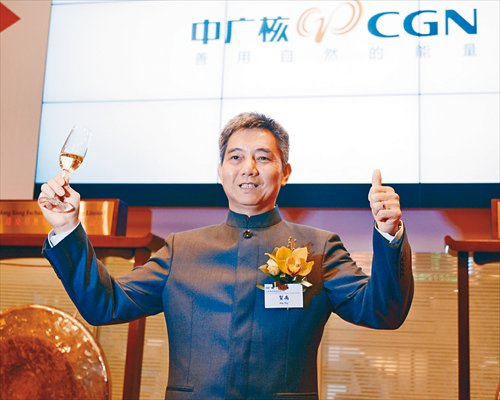No easy route overseas for Chinese nuclear power tech
No easy route overseas for Chinese nuclear power

CGN Chairman He Yu Photo: IC
Editor's Note:
Following Britain's announcement last year that it would give China General Nuclear Power Corp (CGN) a stake in the Hinkley Point nuclear power plant in southwest England, there has been worldwide interest in CGN, which is the world's fifth-largest nuclear power company in terms of operating capacity.
Investment in low-end sectors is not likely to satisfy China, because the country now intends to speed up the process of outbound investment in high-end manufacturing industries such as high-speed rail and nuclear power plants. The question is whether the country can succeed in its endeavor to move up the value chain and achieve high-end manufacturing excellence abroad.
He Yu (He), chairman of CGN and a deputy of the country's top political advisory body, talked to the Global Times (GT) in an interview on Sunday about CGN's existing projects abroad and its future ambitions.
GT: CGN and France-based Electricite de France (EDF) signed a strategic investment agreement last year to build a nuclear power plant at Hinkley Point in England. Is the project progressing smoothly and what kind of role will CGN play in it?
He: The project is on schedule and we are in the process of negotiating the last stages of the contract with our partners. We hope all negotiations can be concluded soon and that we can enter the implementation phase. Our project in Britain has three parts. The first one is the project at Hinkley Point. EDF owns a controlling stake in the project and CGN will contribute 33.5 percent of the total investment. The project will be used to lay the foundations for exporting our own nuclear power technology.
The second one is the nuclear project at Sizewell. CGN will only participate in the pre-construction work, which is a very small part of the project.
The third one is the nuclear project at Bradwell. The project is going to use Hualong One technology, a domestically developed third-generation reactor, and will bring Chinese equipment and management to Britain.
GT: China is promoting its Hualong One technology abroad. Some people have forecast that Hualong One will hold a 20 to 30 percent share of the market in countries along the "One Belt, One Road" route. Do you agree, and will developed countries also be key markets for Hualong One?
He: It is our goal. The Hualong One technology is very competitive in countries along the "One Belt, One Road" route. We are focusing on markets in regions like Southeast Asia and Romania - regions full of opportunities - but we have to make our products competitive.
Developed countries like Britain are also key markets for Hualong One. It will send out a very positive signal to countries around the world if Britain recognizes and adopts the Hualong One technology.
GT: How would you compare Chinese nuclear technology with that in developed countries? It is widely believed that China still lags behind in areas such as core components. And will China simply export nuclear power technology or also take charge of the operation of the nuclear power stations after construction?
He: We have strong advantages in nuclear technology and plant construction. All the standards adopted by Hualong One are in line with international third-generation nuclear power technology, and the domestically developed reactor can also meet standards set up by the US utility requirements document and the European utility requirements document. We hope we can participate in areas like technology, equipment, construction, management and operation.
GT: With concerns rising in overseas markets over the safety of China's domestically developed nuclear power technology, what proportion of domestic technology is adopted in nuclear power stations in China?
He: The development of China's nuclear power industry in the past was based on a process involving introduction of new technology, digestion, absorption and re-innovation. Now the localization rate stands at over 85 percent for nuclear power equipment installed in China. But a high localization rate does not necessarily mean we have independent intellectual property rights (IPR). The challenge remaining for us is how to develop more products with independent IPR. We have to rely on products with independent IPR to compete with our rivals in the overseas markets. This is a big challenge for us.
GT: As China increasingly boosts exports of its nuclear technology, what challenges will the sector face in overseas markets?
He: It is extremely challenging to boost exports of Chinese nuclear technology abroad. A lot of detailed work needs to be done, including understanding the local business environment and public attitude toward nuclear technology. It is simplistic to view investment in nuclear power projects as a purely commercial endeavor because it also needs coordination and promotion by the governments involved.
GT: There are concerns that the overseas expansion of some Chinese State-owned enterprises was boosted by national interests rather than business purposes. Will the projects in Britain make a profit in the future?
He: There is no doubt that the projects in Britain will make a profit. The expected return rate from the project at Hinkley Point is over 9 percent. It is still too early to estimate the return rate from Hualong One at Bradwell due to uncertainty in areas like the price of the power generated.
Read more in Special Coverage:
Newspaper headline: No easy route overseas for Chinese nuclear power